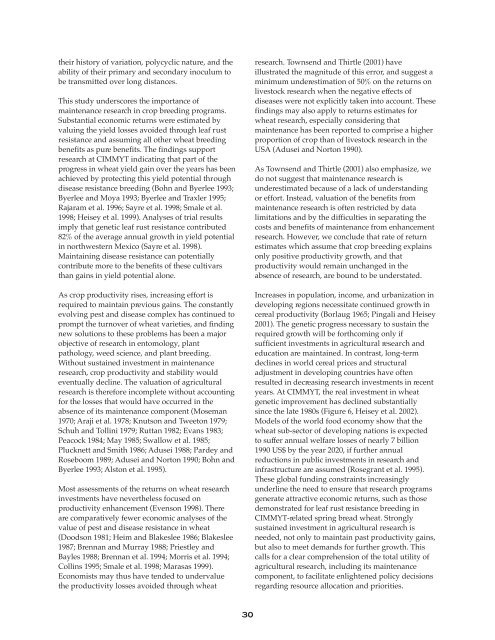The Economic Impact in Developing Countries of ... - AgEcon Search
The Economic Impact in Developing Countries of ... - AgEcon Search
The Economic Impact in Developing Countries of ... - AgEcon Search
- No tags were found...
Create successful ePaper yourself
Turn your PDF publications into a flip-book with our unique Google optimized e-Paper software.
their history <strong>of</strong> variation, polycyclic nature, and theability <strong>of</strong> their primary and secondary <strong>in</strong>oculum tobe transmitted over long distances.This study underscores the importance <strong>of</strong>ma<strong>in</strong>tenance research <strong>in</strong> crop breed<strong>in</strong>g programs.Substantial economic returns were estimated byvalu<strong>in</strong>g the yield losses avoided through leaf rustresistance and assum<strong>in</strong>g all other wheat breed<strong>in</strong>gbenefits as pure benefits. <strong>The</strong> f<strong>in</strong>d<strong>in</strong>gs supportresearch at CIMMYT <strong>in</strong>dicat<strong>in</strong>g that part <strong>of</strong> theprogress <strong>in</strong> wheat yield ga<strong>in</strong> over the years has beenachieved by protect<strong>in</strong>g this yield potential throughdisease resistance breed<strong>in</strong>g (Bohn and Byerlee 1993;Byerlee and Moya 1993; Byerlee and Traxler 1995;Rajaram et al. 1996; Sayre et al. 1998; Smale et al.1998; Heisey et al. 1999). Analyses <strong>of</strong> trial resultsimply that genetic leaf rust resistance contributed82% <strong>of</strong> the average annual growth <strong>in</strong> yield potential<strong>in</strong> northwestern Mexico (Sayre et al. 1998).Ma<strong>in</strong>ta<strong>in</strong><strong>in</strong>g disease resistance can potentiallycontribute more to the benefits <strong>of</strong> these cultivarsthan ga<strong>in</strong>s <strong>in</strong> yield potential alone.As crop productivity rises, <strong>in</strong>creas<strong>in</strong>g effort isrequired to ma<strong>in</strong>ta<strong>in</strong> previous ga<strong>in</strong>s. <strong>The</strong> constantlyevolv<strong>in</strong>g pest and disease complex has cont<strong>in</strong>ued toprompt the turnover <strong>of</strong> wheat varieties, and f<strong>in</strong>d<strong>in</strong>gnew solutions to these problems has been a majorobjective <strong>of</strong> research <strong>in</strong> entomology, plantpathology, weed science, and plant breed<strong>in</strong>g.Without susta<strong>in</strong>ed <strong>in</strong>vestment <strong>in</strong> ma<strong>in</strong>tenanceresearch, crop productivity and stability wouldeventually decl<strong>in</strong>e. <strong>The</strong> valuation <strong>of</strong> agriculturalresearch is therefore <strong>in</strong>complete without account<strong>in</strong>gfor the losses that would have occurred <strong>in</strong> theabsence <strong>of</strong> its ma<strong>in</strong>tenance component (Moseman1970; Araji et al. 1978; Knutson and Tweeton 1979;Schuh and Toll<strong>in</strong>i 1979; Ruttan 1982; Evans 1983;Peacock 1984; May 1985; Swallow et al. 1985;Plucknett and Smith 1986; Adusei 1988; Pardey andRoseboom 1989; Adusei and Norton 1990; Bohn andByerlee 1993; Alston et al. 1995).Most assessments <strong>of</strong> the returns on wheat research<strong>in</strong>vestments have nevertheless focused onproductivity enhancement (Evenson 1998). <strong>The</strong>reare comparatively fewer economic analyses <strong>of</strong> thevalue <strong>of</strong> pest and disease resistance <strong>in</strong> wheat(Doodson 1981; Heim and Blakeslee 1986; Blakeslee1987; Brennan and Murray 1988; Priestley andBayles 1988; Brennan et al. 1994; Morris et al. 1994;Coll<strong>in</strong>s 1995; Smale et al. 1998; Marasas 1999).Economists may thus have tended to undervaluethe productivity losses avoided through wheatresearch. Townsend and Thirtle (2001) haveillustrated the magnitude <strong>of</strong> this error, and suggest am<strong>in</strong>imum underestimation <strong>of</strong> 50% on the returns onlivestock research when the negative effects <strong>of</strong>diseases were not explicitly taken <strong>in</strong>to account. <strong>The</strong>sef<strong>in</strong>d<strong>in</strong>gs may also apply to returns estimates forwheat research, especially consider<strong>in</strong>g thatma<strong>in</strong>tenance has been reported to comprise a higherproportion <strong>of</strong> crop than <strong>of</strong> livestock research <strong>in</strong> theUSA (Adusei and Norton 1990).As Townsend and Thirtle (2001) also emphasize, wedo not suggest that ma<strong>in</strong>tenance research isunderestimated because <strong>of</strong> a lack <strong>of</strong> understand<strong>in</strong>gor effort. Instead, valuation <strong>of</strong> the benefits fromma<strong>in</strong>tenance research is <strong>of</strong>ten restricted by datalimitations and by the difficulties <strong>in</strong> separat<strong>in</strong>g thecosts and benefits <strong>of</strong> ma<strong>in</strong>tenance from enhancementresearch. However, we conclude that rate <strong>of</strong> returnestimates which assume that crop breed<strong>in</strong>g expla<strong>in</strong>sonly positive productivity growth, and thatproductivity would rema<strong>in</strong> unchanged <strong>in</strong> theabsence <strong>of</strong> research, are bound to be understated.Increases <strong>in</strong> population, <strong>in</strong>come, and urbanization <strong>in</strong>develop<strong>in</strong>g regions necessitate cont<strong>in</strong>ued growth <strong>in</strong>cereal productivity (Borlaug 1965; P<strong>in</strong>gali and Heisey2001). <strong>The</strong> genetic progress necessary to susta<strong>in</strong> therequired growth will be forthcom<strong>in</strong>g only ifsufficient <strong>in</strong>vestments <strong>in</strong> agricultural research andeducation are ma<strong>in</strong>ta<strong>in</strong>ed. In contrast, long-termdecl<strong>in</strong>es <strong>in</strong> world cereal prices and structuraladjustment <strong>in</strong> develop<strong>in</strong>g countries have <strong>of</strong>tenresulted <strong>in</strong> decreas<strong>in</strong>g research <strong>in</strong>vestments <strong>in</strong> recentyears. At CIMMYT, the real <strong>in</strong>vestment <strong>in</strong> wheatgenetic improvement has decl<strong>in</strong>ed substantiallys<strong>in</strong>ce the late 1980s (Figure 6, Heisey et al. 2002).Models <strong>of</strong> the world food economy show that thewheat sub-sector <strong>of</strong> develop<strong>in</strong>g nations is expectedto suffer annual welfare losses <strong>of</strong> nearly 7 billion1990 US$ by the year 2020, if further annualreductions <strong>in</strong> public <strong>in</strong>vestments <strong>in</strong> research and<strong>in</strong>frastructure are assumed (Rosegrant et al. 1995).<strong>The</strong>se global fund<strong>in</strong>g constra<strong>in</strong>ts <strong>in</strong>creas<strong>in</strong>glyunderl<strong>in</strong>e the need to ensure that research programsgenerate attractive economic returns, such as thosedemonstrated for leaf rust resistance breed<strong>in</strong>g <strong>in</strong>CIMMYT-related spr<strong>in</strong>g bread wheat. Stronglysusta<strong>in</strong>ed <strong>in</strong>vestment <strong>in</strong> agricultural research isneeded, not only to ma<strong>in</strong>ta<strong>in</strong> past productivity ga<strong>in</strong>s,but also to meet demands for further growth. Thiscalls for a clear comprehension <strong>of</strong> the total utility <strong>of</strong>agricultural research, <strong>in</strong>clud<strong>in</strong>g its ma<strong>in</strong>tenancecomponent, to facilitate enlightened policy decisionsregard<strong>in</strong>g resource allocation and priorities.30
















